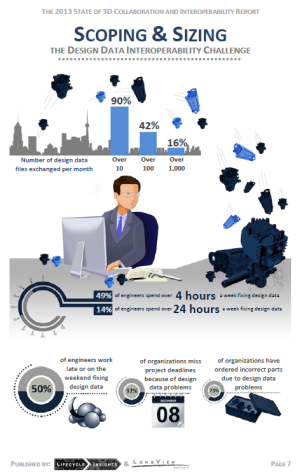Data Interoperability for Digital Manufacturing

As we discussed in our last blog post, “Improving Manufacturability--Design Data Sharing”, effectively leveraging 3D CAD design data to non-CAD users is crucial for successful manufacturing companies.
Companies who desire to use digital manufacturing (a.k.a. digital mock-up - DMU) across their extended enterprise today often find it challenging to easily share their design data due to interoperability issues. For example, engineers often take data from the native CAD format and spend hours a week fixing it for use by non-CAD users. Poor interoperability is a huge problem, resulting in wasted time and design delays.
Chapter 2 of “The 2013 State of 3D Collaboration and Interoperability Report” details the data interoperability problem. Chad Jackson of Lifecycle Insights and David Prawl of LongView Advisors surveyed hundreds of companies who do product development. They asked participants about their use of 3D along the critical path from engineering to manufacturing. Their revealing findings are in this comprehensive, free report.
We have included the commentary below from chapter 2, highlighting data interoperability and sharing 3D design data.
The Design Data Interoperability Challenge
Interoperability? There is none! Every automotive customer wants to see his own defined native format of his version of a specific CAD application. For years, there are initiatives to have standards, but in fact every department from OEM side is asking for native data (sometimes including check from third party checking tools). This causes a lot of administrative work to keep all the software levels accurate and also a lot of training for the CAD engineers.
Stefan Harig, Strategic IT Group, SaarGummi technologies, Automotive Supplier, Germany
This is probably the most important metric, as it again portrays the highly publicized huge cost of poor interoperability. Yes, one might say we’ve been talking about this for a long time, but here’s proof of the huge cost burden that still plagues suppliers and producers alike. Simple math shows the tremendous magnitude of the cost. And this is all non-value-added work, in lean terms. It is indeed surprising the number of companies who pride themselves in their lean operations who also ignore this cost and leave it to their engineers to deal with (on their nights and weekends). Wouldn’t they rather have their people creating better products?
Dave Prawel, Founder and President, Longview Advisors
Although most of the vendors today claim that they have interoperability I think this is not a reality today. It can work if you are not going to modify the design, or will use it only as a context in a DMU environment.
Marco Cecchini, Embraer, Aerospace OEM, Brazil
Why is so much time being wasted sharing 3D files? Our guess is data conversion issues. XVL enables a single backbone for sharing across the extended enterprise.
Productivity: With our tools, data is converted directly from the CAD system (manually or automated). Once in XVL, additional information can be added such as work instructions, mBOMs, and animations. Associativity to the original CAD model/s is maintained, so when a design change is made in the native CAD, the updated geometry is reflected in the XVL model.
Sharing: With XVL, it is simple to share (filesizes are typically ½ % of the CAD file) with full-functioning, no-cost players.
Security: Lastly, multiple levels of security and control over model fidelity ensure that designs and data can be easily protected and only accessed by those you want to have access.
Bill Barnes, GM Americas and EMEA, Lattice Technology
These findings confirm what I've suspected for some time. Yes, a lot of design data files are flying around. Yes, a lot of engineer's time is consuming in dealing with that. But there's no give in the schedule. Its just more work that needs to be done in the same amount of time. That's why engineers end up working late and on the weekend.
Chad Jackson, Industry Analyst, Lifecycle Insights

